There are a number of ways you can look after the daily wear and tear of driving on Australian roads, and save yourself money when it comes time for that full car service.
By looking after the little things, you can stop small repairs becoming large – which could cost you both money and more time off the road.
Here are our Top 7 Tips:
1. TYRES
The only thing between you and the road are your tyres. It makes sense then that you should keep a regular check on them. Little things you notice now could make a big difference in the long run.
Tyres should have at least a continuous 1.5 mm depth of tread, and be free of any defects. But how do you judge the depth of tread. It’s actually really easy when you know what you’re looking for.
Each of your tyres will have at least four wear indicators to show you when the tread has worn down to 1.6 mm. You’ll find them on the side wall of the tyre, on the edge of the tread.
They are small triangles, pointing to bars moulded within the tread. These bars are the wear indicators, and if the tread pattern is level with the wear indicator then it is time to replace your tyres. This is definitely not something you should hold off on doing until your next service, it’s crucial that your tyres have the correct tread every time you hit the road.
Read more about the importance of your tyres here.

Wheel inflation, alignment, and balance
Keep an eye out too for uneven wear, which signifies you’ve either got incorrect tyre inflation or it’s time for a wheel alignment and/or balance.
The right time to check your tyre inflation is when the tyres are cold. The pressure in your tyres will change after a long drive, so check the pressures before you head off on a trip.
A wheel alignment is recommended every 10,000 kilometres, or if you start to notice the vehicle pulling to one side when driving on an even surface.
If you require a wheel balance you may notice vibration through your steering wheel.
Tyre pressures are different depending on the types of tyres and vehicles. You can check the pressures by looking at the vehicle plate, usually found on the inside of the door sill, which will give you your car’s tyre pressure recommendations. Many cars have different pressure suggestions based on how many passengers normally travel in the car, so it’s worth taking note of that and adjusting your pressures accordingly.
2. WINDSCREEN AND WIPERS
Windscreen chips and cracks
Apart from making your car fail a roadworthy test, chips or cracks in your windscreen can affect your view and make your car unsafe to drive.
A chip in your windscreen can turn into a large crack very quickly, so it’s best to have a chip fixed as soon as possible. This little fix can help to save you in the long run by helping you avoid having to replace the whole windscreen.
Damaged windscreens leave you susceptible to water damage, weakening of the vehicle structure, and could even affect the operation of the airbags.
Washing your car or sitting at traffic lights are the perfect time to have a good look at the windscreen and make a note of any chips, and then get them looked at.
Another little tip that can help to save you in the long run is to visit your local windscreen repairer and pick up some chip stickers.
These can temporarily cover a chip in the windscreen and stop it from becoming a larger crack.

Wiper blades
Things like dirt, sunlight, extreme weather, and contaminants can cause your wiper blades and refills to get damaged over time.
It’s pretty easy to tell when your wiper blades or refills need replacing. You’ll start to experience streaks, get wiper judder, smearing, or parts of the windscreen will stay unwiped.
If you see any of these signs, it’s easy enough to pick up a replacement set and fix it yourself, or, some car accessory stores will even replace them for you.
This is a smarter way to do it rather than waiting for your regular car service, where you’ll be charged a premium for parts and labour of putting on the new blades.
3. LIGHTS
It’s important that your brake lights, reverse lights, indicators, fog lights and headlights are always working.
It’s a good idea every now and then to get a friend to walk around your car while you turn on all the lights to check they’re all working fine.
If you’re on your own and want to check, just find a reflective building that you can park in front of so you can see the lights working (or not) in the reflection.
Replacing bulbs in your car is a pretty easy job, just take a look through the owner’s manual for details on how to do it. You can save yourself money by doing it yourself too, rather than waiting until your next car service rolls around.
If you do decide to use the experts, here’s a bit of an idea of how much it will cost to get brake light bulbs replaced.
4. FLUID LEAKS
Ever noticed in shopping centre car parks a black stain in a lot of the car spaces? This is from fluids, usually engine oil, leaking from vehicles that have parked there.
If you notice a stain or puddle in your normal parking space, your car might be leaking engine oil or some other type of automotive fluid.
A puddle of clear water under your car after you’ve been using your air conditioner is quite normal though – so don’t get too concerned by that.
It’s just condensation from cold components of the air con system hitting the warm air outside.
If there is a puddle under your car though, and it’s not clear water, take a note of the colour of the fluid, and how large the puddle is. It can even help to take a couple of photos of it on your phone, and then chat to a local mechanic. There may be an easy fix that you can make now and save yourself further cost at servicing time.
Another tip is to keep an eye on the warning lights on your dash, as they will light up if certain fluids are too low – which could signal a more serious leak.
If you were to have a serious coolant or engine oil leak and kept driving, you could overheat and cause damage to your engine. So if the warning light comes on, pull over and call for help.
To sum up what you need to remember - keep an eye out for any murky puddles under the car, actively check your oil dipstick at least once a month and be alert for any warning lights, should they appear.
Six of the most common fluids that leak from your car are outlined here.
If you own a manual car, there’s one more leak you need to keep an eye out for, which is leakage from your clutch master cylinder.
If the seal breaks or is worn away, fluid will enter the car via the clutch pedal, and deposit itself on your shoes, or car mat. If this happens, have it looked at by a mechanic straight away, as it could end up meaning you’re unable to change gear.
5. FUEL CONSUMPTION
Another little thing that can save you in the long run is to keep an eye on your fuel consumption. It could be just a little bit over time, or realising that it’s costing you more at the pump but it’s not because of higher mileage or fuel prices. There’s a whole bunch of reasons for higher fuel consumption, including:
- Fuel Leaks
- Dirty fuel injectors
- Incorrect timing
- Worn or damaged spark plugs, leads, coils or distributor
- Low octane fuel
- Incorrect tyre pressure
- Defective thermostat
- Defective oxygen sensor
- Worn timing belt
- Dirty air filter
- Incorrect valve clearance
- Worn rings or valves
- Defective MAP sensor
- Clogged catalytic converter, exhaust
If you notice changes in your fuel economy, see if your local mechanic can address the problem. The earlier they fix your fuel issues, the less you will pay at the pump in the long run.
There’s also a stack of ways you can increase your fuel efficiency every time you hit the road:
- Use a higher octane fuel, it may cost more but is worth it in the long run. Buying the cheapest fuel may not be the best in the long term for your car.
- Buy fuel from a busy service station that regularly turns over its fuel.
- Check your tyre pressure regularly.
- Avoid accelerating and braking heavily.
- Whenever possible don’t drive on an almost empty tank.
- Remove the roof rack if it's not being used.
If you do a lot of city-style, stop-start driving through the week, then try to take your vehicle for a longer drive along the highway on weekends.
Heading out for a run where you’re doing at least 80 kilometres per hour for a long period, allows the engine to get up to temperature and at higher revs to give it a clear run. This can even help in charging your battery.
6. ENGINE TROUBLES OR LOSS OF POWER
Ever had that feeling where your engine begins to shudder when idle, or has a skip/jerk when accelerating?
You might be finding it harder to get up hills, can’t pull away at the lights as quickly, or you put your foot down to overtake someone on the highway only to find there’s nothing there.
So what could be going on?
- Incorrect timing
- Airflow obstruction
- Worn or fouled spark plugs
- Poor fuel
- Incorrect air/fuel ratio
- Faulty ignition source
- Electrical fault
- Faulty sensors
- Transmission faults
If you experience weird engine action at idle or during acceleration, then it’s best to have your car looked at by a mechanic. If you keep driving you could be doing damage to your engine in the long run. Here’s an indicative guide of the costs involved with having it checked out.
As an example, worn spark plugs can eventually burn out your coils, which will then stop cylinder operation, and soon you won’t be able to drive your car at all.
So, a small shudder or a loss of power that you ignore can go from being a small expense to a major expense, and could leave you carless for quite a while.
7. ENGINE BECOMES HARD TO START
Sometimes an engine has trouble starting, and it can happen when the engine is either cold or warm. Some of the common causes for this trouble are:
- Starter motor
- Ignition
- Air/fuel issues
- Battery
If it’s the starter motor causing the problem, your dash lights will likely remain bright, but you’ll probably experience a single click, or no sound, no crank, or no start when you try to start the car. If any of these happen, you’ll need to make a trip to a local auto electrician.
If your car cranks over fine but doesn’t start, then there might be an issue with the air, fuel or ignition.
All of these features are needed to start a car, so if this is going on, you’ll need to get a mechanic to work out what the actual problem is.
Other non-starting issues that can come up may be due to your ignition key, and alarm/immobiliser if you’ve got one. You may need to replace the key, transmitter or transmitter battery.
Another cause of starter issues may be if your battery is weak, dead, or has a poor connection. Some tell-tale signs that this is the problem include your dash lights becoming dead or very weak, electric windows becoming slow, and your interior lights will remain dim at all times.
If this is happening to you, check your battery terminals are connected correctly, and that they’re not corroded. It could also mean that your battery is reaching the end of its lifespan.
How to get a longer life out of your car battery
You should be looking to get at least two years of life out of your battery. Here are some little things you can do to get more life out of your car battery:
- Avoid leaving car accessories on which drain the battery.
- Keep your battery clean
- Make sure the battery is secured down so it doesn’t vibrate and terminals become loose
- Jump-starting a flat battery can do damage so get assistance from a professional
- Have your batteries charging rate checked when the car is being serviced
- Drive your vehicle regularly, if it is sitting for extended periods of time this will affect the battery charge
- Never use tap water to top up water in your battery. Only use distilled, demineralised or deionised water or if you are in a desperate situation then you can use clean rainwater.
If a battery is being replaced or disconnected, a memory minder should be used to keep the power supply constant. This’ll make sure that the computer won’t lose your idle memory speed and you won’t need to re-enter your radio security code.
Another thing to keep in mind if you live in a hot part of Australia, the warmer weather will reduce a battery’s life due to faster water loss. So if you live in a hotter region you should look for a battery with a larger reservoir — more water means more time until it’s low.
If your battery does need replacing, and you’re confident to do it yourself, here are some tips and tricks on replacing it.
SOURCES:
Fairleigh Dickinson University



